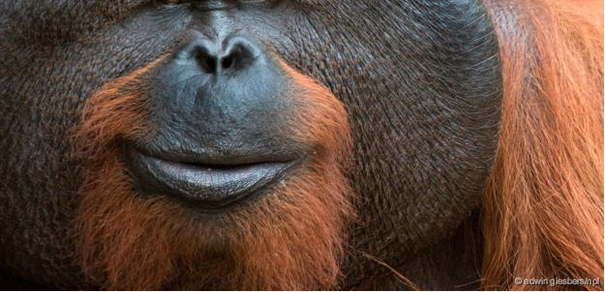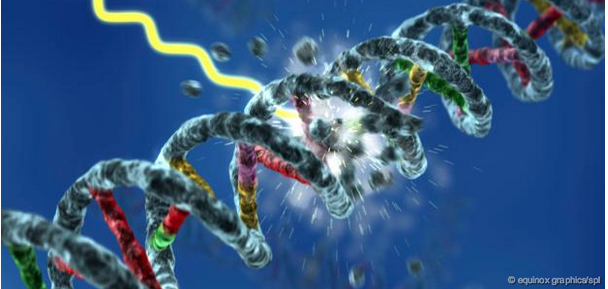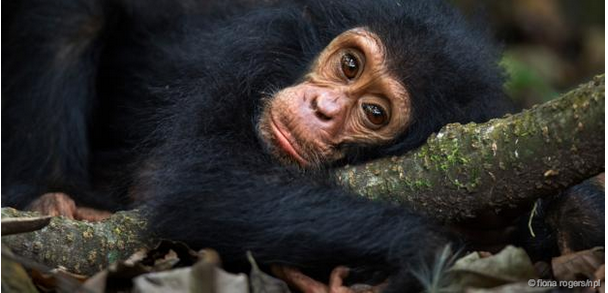We think of psychological disorders like anxiety and depression as uniquely human problems, but many other species could be suffering from them tooFlint was hit hard when his mother Flo passed away. He became withdrawn and stared into space. He also stopped eating and became weak. After a few days, Flint rested close to where his mother had lain, and died.
Flint was a chimpanzee living in Gombe National Park in Tanzania. His story was described by primatologist
Jane Goodall in her 2010 book
Through a Window. She contends that he was suffering from depression.
To our eyes, many animals seem to suffer from forms of mental illness. Whether they are pets, or animals kept in ill-managed zoos and circuses, they can become excessively sad, anxious, or even traumatised.
We have tended to think of psychological illnesses as a uniquely human trait.
But that may be wrong. There is growing evidence that many animals can suffer from mental health disorders similar to those seen in humans. These unfortunate animals could help us understand how and why humans become mentally ill, and why these debilitating disorders ever evolved at all.

© Edwin Giesbers/NPLWe don't know what's going on in this orangutan's mind
Many of us have seen or heard of pets that become sad after the loss of a companion. Sometimes, their loss is too deep to recover from, and they may even die - as Flint apparently did.
But animal mental illness can take many forms. Some pet birds
obsessively pluck their feathers, and some dogs obsessively lick their tails or paws, much as some humans obsessively clean their hands. Some animals are also known to
self-harm, for instance pulling out their own hair.
It seems that animal mental illness can be triggered by many of the same factors that unleash mental illness in humans. That includes the loss of family or companions, loss of freedom, stress, trauma and abuse.This is most easily seen in animals that are held in captivity.

© Jabruson/NPLChimpanzees held in captivity show signs of stress
In a 2011 study, scientists found
signs of depression and post-traumatic stress disorder (PTSD) in chimpanzees that had been used in laboratory research, orphaned, trapped by snares, or been part of illegal trade.
Stressful events can even leave marks on animals' genes. In 2014, researchers found that African grey parrots that were housed alone suffered more genetic damage than parrots that were housed in pairs.
The researchers examined the parrots' telomeres: caps on the ends of their chromosomes that slowly deteriorate with age or stress. 9-year-old parrots that were raised alone had
telomeres as short as pair-housed birds that were 23 years older.
It seems that social deprivation is stressful for parrots, just as it is for humans. Other stressful events can also leave their mark on animals.
© Lynn M. Stone/NPLTraumatised dogs often show signs of anxiety or PTSD
For example, many
military dogs are thought to be suffering from a canine form of PTSD. They behave similarly to war-traumatised soldiers. Some of these dogs are being treated using drugs used to cure panic attacks and anxiety in humans.
Similar behaviours, such as shaking with fear, are often seen in civilian dogs that have been through a
natural disaster or been abandoned by their owners.
So far, all these examples have come from captive mammals or pets. That probably reflects our own preferences for certain animals.
"It's the animals that we find very charismatic, like elephants or chimpanzees, or animals that we share our homes with, like dogs," that command our attention, says animal behaviour expert
Marc Bekoff.
But this doesn't mean that animals in the wild cannot suffer from mental illnesses.
© Peter Cairns/NPLCoyotes (Canis latrans) lead tough lives in the wild
Bekoff has seen an oddly behaving wild coyote pup, which he nicknamed Harry, in
Grand Teton National Park in Wyoming.
"He didn't quite get what it was to be a coyote," says Bekoff. "He was socially very maladaptive, and he didn't seem to understand what other coyotes were saying to him or doing. And he didn't seem to know how to play."
In his 2008 book
The Emotional Lives of Animals, Bekoff suggested that "Harry suffered from coyote autism".
But that is only a suggestion. So far, spotting wild animals that are suffering from mental disorders has proved tricky.

© Tom Mangelsen/NPLAn anecdote describes a mentally ill coyote (Canis latrans)
There may be a simple reason for that: maybe animals with mental disorders don't make it in the wild. They do not necessarily get the care or support that mentally ill humans do, so if they can't perform critical tasks they may not survive long.
That's possible, but it could also be that people simply haven't looked, says Bekoff. Even if they see animals that seem sad or otherwise behaving oddly, they usually don't try to figure out what could be happening.
More profoundly, it is difficult to tell if a seemingly abnormal behaviour is a sign of illness, or just out of the ordinary. In many cases we don't know enough about what constitutes "normal behaviour" to decide.

© PhotoAlto/Alamy Stock Photo
Sometimes, "it's very clearly a disease and something is wrong with the animal," says
Eric Vallender of the University of Mississippi in Jackson. But what if an animal has been through a stressful experience, yet seems unaffected?
"What's unclear then is whether this is because it doesn't look any different to me as an observer, a human watching the animal, but another animal would say that there is something different," says Vallender. "Or if there's truly no difference."
Doctors can ask human patients how they feel, but animals cannot tell us if they are sad or happy, or if they are hallucinating.
"All you can do with animals is to observe them," says Vallender. "Imagine if you could study mental disorders in humans only by observing them. It would be really hard to tell what's going on in their brain."
Faced with these obstacles, scientists have begun looking at animals' genes.

© Science Photo Library/Alamy Stock PhotoOur DNA affects our mental health
"A lot of mental disorders can be quite different.
But what we do know is that they have a very, very strong genetic component to them," says
Jess Nithianantharajah of the Florey Institute of Neuroscience and Mental Health in Melbourne, Australia.
All mental disorders, from depression to schizophrenia, involve abnormal behaviours. Those behaviours are influenced by genes just like other behaviours.
So the idea is to identify genes that can cause abnormal behaviours in humans and other animals. By tracing the origins of these genes, we can trace the origins of mental disorders.
Perhaps unsurprisingly, it turns out that many of the genes implicated in mental illnesses are involved in brain function.

© Science Photo Library/Alamy Stock PhotoSynapses are the links between neurons
Some of the most important parts of our brains are the synapses: junctions between individual brain cells that allow them to transfer information. Synapses are involved in many cognitive processes, such as learning new facts and paying attention.
Many mental health disorders arise when something goes wrong with these aspects of the brain. For example, many children with autism have learning disabilities, and patients with schizophrenia find it difficult to form coherent thoughts.
A host of genes are involved in building synapses. These genes code for proteins that assemble into synaptic junctions, and Nithianantharajah says they are at the core of many cognitive processes.
In a
2012 study, Nithianantharajah and her colleagues reconstructed the history of one family of synapse genes, known as
Dlg.

© Science Photo Library/Alamy Stock PhotoBrains are made of interlinked neurons
Invertebrates - animals like flies and squid that lack backbones - have only one
Dlg gene. But all vertebrates - backboned animals like fish, birds and apes - have four.
During the course of evolution, the original
Dlg gene was duplicated twice, giving rise to the four copies found in vertebrates, says Nithianantharajah. These gene duplication events happened about 550 million years ago, possibly in a tiny worm living in the sea.
The four
Dlg genes found in vertebrates are subtly different, and the team found that each one regulates distinct cognitive behaviours.
"What this means is that we have far more tools in our repertoire to be able to perform different types of complex behaviours, that many invertebrates don't necessarily do," says Nithianantharajah.

© Sebastian Kaulitzki/Alamy Stock PhotoNeurons are at the root of many disorders
In invertebrates that only have one Dlg gene, the gene can only be turned on or off, like a light.
But in vertebrates that have four copies of the genes, the genes act like a dimmer switch: they can be turned up and down in different combinations, allowing the animal to fine-tune behaviours.
In short, the genetic duplication events gave vertebrates a wider range of genes, enabling them to have more varied and complex behaviours.
But there was a cost. Mutations in these extra
Dlg genes can give rise to many psychological disorders.

© Equinox Graphics/SPLWhen our DNA changes, disease is often the result
Nithianantharajah's team found that mice and humans with mutations in any of their
Dlg genes had problems with various cognitive tests.
They also found that the
Dlg genes have not changed much over evolutionary time. Nithianantharajah says that is because they are so fundamentally important to animals' brains, so evolution has largely kept them as they were.
Her data suggests that
Dlg had its origins in the simplest of animals. That would imply that both intelligence and psychological disorders also began early in animal evolution.
Based on that, Nithianantharajah says, it is possible that invertebrates like honeybees and octopuses could also experience mental illness.

© Kim Taylor/NPLHoneybees (Apis mellifera) are affected by stressful experiences
"We know that mutations in certain brain genes, and particularly the synaptic genes, play a large role in disrupting behaviour," says Nithianantharajah. "That's the core of what a mental disorder is. So just like in vertebrates, if you mutate various synaptic genes in invertebrates, you could lead to abnormal behaviour."
So far no such study has been published, but there is observational evidence that invertebrates really do suffer mental disorders.
A 2011 study subjected honeybees to violent shaking, and found that they seemingly became
more pessimistic as a result. Faced with a smell they could not identify, they were more likely to behave as if it was unpleasant.
Perhaps this shouldn't be surprising.
While we tend to think of invertebrates as "lower" animals, lots of them do have brains and many are far more intelligent than the stereotype would suggest.That said, it is one thing to suggest that animals like dogs or even bees might suffer from emotional disorders like depression or anxiety. Other mental illnesses like schizophrenia seem to affect more complex forms of thought, so we might expect them to be exclusive to humans.
But that may not be the case.
© Chris & Monique Fallows/NPLCould dolphins suffer from anxiety or depression?
In a
2014 study, Vallender and his colleague
Lisa Ogawa studied genes thought to be associated with schizophrenia and autism in 45 mammalian species.
If these genes had changed more in humans than in other species, it would imply that the disorders were exclusively human.
But that was not the case. The genes had changed in humans, but also in Old World monkeys, apes, and even distantly-related mammals like dolphins.
So far it's not clear what this actually means for these animals' mental health, says Vallender. "All we know at this point is that the proteins seem to be changing."

© Tim Laman/NPLMental illness may have a long evolutionary history
There is a long way to go, but genetic studies like these do suggest that all animals with brains have the capacity to lose some aspects of their minds.
From our point of view, this may actually be a good thing, because it offers hope for better treatments.
Many of the therapies and drugs that are being developed to treat human mental disorders are being tested on animals. That only makes sense if the animal in question has a brain that works similarly to ours.
"If a human breaks a leg, or if a cat or horse breaks a leg, a broken leg is a broken leg. The species does not matter much," Vallender says. "But mental health is really different. This is because the human brain is very different from other species, and we really need to understand the things that are the same about it and those that are different."

© Fiona Rogers/NPLChimpanzees can surely be sad, but depression is not the same
It's still common to see mental illness branded as a form of weakness. We struggle to understand that people with severe depression or anxiety cannot simply "get over it", any more than a person could will themselves to survive a heart attack.
But far from being something limited to pampered modern humans, mental illness can strike many kinds of animals and seems to have been around for hundreds of millions of years. Just like seemingly more physical disorders like cancer, it can be traced back to mechanical things such as genes and proteins within our cells.
Mental disorders seem to be the price animals pay for their intelligence. The same genes that made us smart also predisposed us to madness. There's nothing shameful in that.
Stress reduces telomeres?